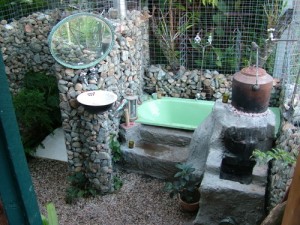OK, so in The Bathroom Worth the 30 Years’ Wait, I promised the Rocket Stove Bath story. For Siobhanne and others who have asked, here it is.
For many years we had a star bath – a cast iron bathtub out in the open with a wood fire underneath it. It had its charms, great charms – a clear view of a starry sky, a bath that stayed warm as long as you like, hot water from renewables even in the depths of winter. But it also had drawbacks – the need to light the fire several hours before bath time, a fair consumption of firewood, no bath in the rain, or even after rain with a fireplace that got very wet, smoky fires, a bath that needed a deal of cleaning at the start of winter.
So the idea was to claim all the charms without the drawbacks, and the rocket stove bath has pretty well aced it. It is under a roof and has walls most of the way round but still a view of a starry sky. Many of my best ideas happen while considering that sky. It has a chimney that goes all the way along under it, which means the bottom is warm and stays warm for as long as you are willing to add a few sticks every half hour or so. It is very frugal in its use of wood – a bundle of sticks that I collect from under gum trees along the roadside on my morning walk. And it burns remarkably clean.
Rocket stoves are a classic design. The essence of the idea is a vertical combustion chamber that is very well insulated. Being insulated, it quickly becomes the hottest part of the system, and since heat rises, flame is drawn into it. Being insulated too, it gets up to very high temperatures and burns all the volatile gases and smoke that cooler fires let escape. The efficiency makes them ideal for cooking stoves in places where firewood is scarce and for space heating with wood fires in cold climates.
Being a classic design, there’s quite a bit of information around the internet about the basic principles but not much about using them in this application. So this is my rundown on how we did it, and the things I think might be optional and the things that might be critical.
Step One: The design
The critical dimensions for a rocket stove are critical. There is a good explanation at Design Principles for Wood Burning Cook Stoves that uses research by the lodestars of rocket stoves Dr. Samuel Baldwin and Dr. Larry Winiarski setting out the reasons.
For our purposes:
This is a diagram of the basic design.
- The diameter of the chamber that the hot gases flow through has to be the same all the way through the system. Not necessarily the same shape, but the same size. So the horizontal fire chamber, the vertical rocket chamber, the hot gas drop chamber, the chimney, all have to have the same area for the gases to flow through. If you “choke” the gas at any point, it doesn’t work. For example if you use a 6 inch pipe, it has a cross sectional area of 30 sq inches. All exhaust pipes, flues, etc after that can’t be less than 30 sq inches ( or it will throttle the gas trying to escape.) You can use bigger, or smaller pipe in the burn chamber, and you then need to calculate the cross sectional area and make the flue pipes or exhaust pipe match that size.
- The length of the vertical rocket chamber (the long vertical bit) has to be greater than 3 times the length of the feed chamber and greater than twice the length of the fire chamber. So a vertical rocket chamber that’s is 900 mm high for example from top to bottom, can have a feed chamber that is less than 300 mm from top to bottom, and a horizontal fire chamber (the horizontal bit) that is less than 450 mm long.
We got a specialist plumbing supplier to make up our rocket, burn and feed chamber out of heavy stainless steel. It was expensive, but since we were planning to concrete the whole system into place, we didn’t want to risk it ever burning out, and the temperatures get very hot. We made ours 6 inch (150mm) diameter. We debated it. Lewie was barracking for 5 inch (125mm). I couldn’t conceive of a smaller pipe taking enough wood to heat a bathtub of water, but in retrospect he may have been right. If anyone has tried smaller, let us know!
The plumber did a little design modification on his own, and made the burn chamber go horizontally for 6 inches then at a 45° angle, I think just because it made an easier and stronger weld. In retrospect, I don’t know that it was a great idea. I would probably insist on it being horizontal if we were doing it again.
Our rocket chamber is 32 inches (81cm) tall.
Over the rocket chamber is a sleeve of galvanised 10 inch (25cm) pipe, and the gap between the sleeve and the rocket chamber is filled with rock wool. In Version 1, it was filled with perlite. We lit it up to try it out. It worked beautifully for a couple of baths then stopped working. Giant frustration. Took a while then we figured out that the perlite had all settled and compacted and wasn’t up to the job of insulation. Vacuuming out the perlite to replace it with rock wool was interesting.
After the insulated rocket chamber the gases drop between the galvanised pipe and the bricks, and go out through a galvanised chimney pipe (the curved pipe on the left hand side in this picture). At the bottom the pipe turns at 90°to the centre of the bath, then turns again and travels under the centre of the bath to come out at the head. The bit under the bath is rectangular guttering stuck to the bottom of the bath. Under the bath is filled with perlite and bricked in. (We had a stack of old bricks put to good use on the project).
At the head of the bath, the chimney turns 90°again and goes up through the rock gabion wall (later filled with rocks). It has a little cap on top, mostly just to look pretty, and above it the alsynite roof is shielded with a small sheet of metal. A little smoke comes out when the fire is first lit, but after that not much comes out the chimney, not as heat or smoke.
Version 2, with rock wool insulation, worked beautifully most of the time. And sometimes just refused. For no good reason.
We never have totally figured out why. It’s one of those things where you make several changes and can’t tell which one worked, or if they all did. But three modifications later, the system is working perfectly and perfectly reliably. Mod 1: we installed a small fan recycled from a computer in the chimney as a suction. The idea came from some camping rocket stove designs we found that incorporated a fan. Mod 2: We built a little semi-circular shovel to be able to remove ash from the burn chamber while the fire was going. We found that ash in that chamber tended to reduce its area and choke the fire if you have it going for more than one long bath. Mod 3: We found a pudding basin that fits very neatly in the open end of the burn chamber – if you look at the first photo in this post you will see it. We found that letting any air at all in that way made the fire more likely to burn up the sticks rather than horizontally as it is supposed to.
So, the final system. We can fill the bath with warm water from the solar system, or cold water if it has been really cold and overcast. With warm water, the bath is ready in half an hour. With cold a little longer. It probably doesn’t get hot enough directly under the bath to crack the enamel (as it would with the star bath) but I haven’t wanted to test that. We fill it first and have a boogie board we put in the bath while it is warming so as to insulate it.
There is a big urn lives beside the stove with sticks for the fire. We use eucalypt sticks about one to two inch diameter (25 to 50 mm). Light a small fire in the bottom of the feed chamber, stand four or five sticks in it, and the flame burns horizontally through the burn chamber and roars up the rocket chamber. The top of the rocket chamber has a big pot with a tap. This gets very hot and can be added to get the bath to toasty, and refilled from the tap above it.
The hot gases flow along the chimney under the bath keeping it warm. The sticks drop into the fire as they burn. If you intend staying in more than half an hour or so, a bath wallah to add more sticks is very helpful. And to bring more wine.









Thanks for showing us the great bath design
Hello, I was wondering if anyone has used this design in a northern climate where outdoor temperatures are around -5C (23F) and if so how long wold you expect the water temperature to rise to a comfortable bath temp?
Do you have any more diagrams or pictures of this design listed on this website?
Hi Robert, I don’t have any more to add except that, a couple of years later we are still really happy with it. I don’t have experience with very cold climates – we’re subtropical here, rarely down to freezing even in the depths of a winter night. If anyone has tried it in a cold climate, I $d be interested yo hear too.
Hi Robert, I don’t have any more to add except that, a couple of years later we are still really happy with it. I don’t have experience with very cold climates – we’re subtropical here, rarely down to freezing even in the depths of a winter night. If anyone has tried it in a cold climate, I’d be interested to hear too.